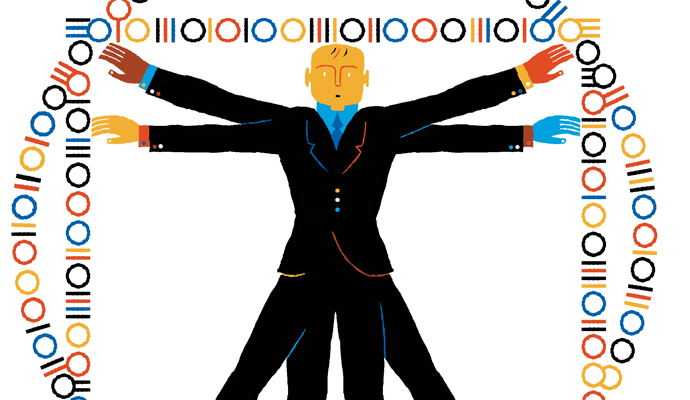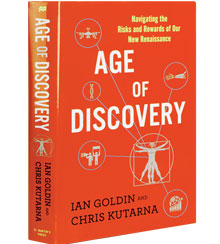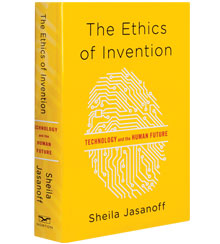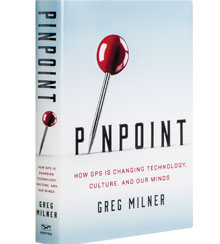Best Business Books 2016: Technology
The Human Function
Ian Goldin and Chris Kutarna
Age of Discovery: Navigating the Risks and Rewards of Our New Renaissance (St. Martin’s Press, 2016)
Sheila Jasanoff
The Ethics of Invention: Technology and the Human Future (W.W. Norton, 2016)
Greg Milner
Pinpoint: How GPS Is Changing Technology, Culture, and Our Minds (W.W. Norton, 2016)
*A TOP SHELF PICK
Books about technology tend to fall into one of two categories: wide-eyed boosterism or gloomy dystopianism. And although both utopian tracts and bleak jeremiads have their uses, the most compelling, like this year’s best books on technology, are keenly aware of the two-sided nature of new technologies. On the one hand, they expand our range of possibilities, create new opportunities, and sometimes dramatically improve our everyday lives. On the other, they often bring with them unforeseen negative consequences, concentrate power in the hands of those who own or control the technologies, and disrupt the existing order in unsettling ways.
At first glance, Age of Discovery: Navigating the Risks and Rewards of Our New Renaissance, by Ian Goldin and Chris Kutarna, might look like a classic utopian text. At a time of profound skepticism about globalization and doubt about the prospects for future innovation, Goldin and Kutarna are unabashed in their advocacy of the benefits of globalization and convinced that technology is transforming the world. The book is structured on the idea that our current era (which they define as beginning in 1990, with the end of the Cold War) is a “new Renaissance,” which is in important respects similar to the first Renaissance. As a result, the authors begin their chapters with a look at that earlier era (which they date from 1450 to 1550), and use the historical comparisons to illuminate the current state of the world.
Age of Discovery is a useful reminder of the extraordinary gains that have been reaped by much of the world’s population over the past 25 years, including a precipitous decline in the number of people living in extreme poverty and a sharp rise in global life expectancy. The fact that the lion’s share of those gains have come as a result of China’s steep economic ascent doesn’t make the gains any less real. Goldin, a former World Bank official who is director of the Oxford Martin School at the University of Oxford, and Kutarna, a fellow at the Martin School, also make a strong case that the sciences, in particular, are seeing what they call “Copernican revolutions” in fields such as synthetic biology, nanotechnology, and computing. They also show how technological progress is being spurred by greater connectivity, which has enabled the harnessing of the collective intelligence and effort of large groups of people in enterprises as varied as translating texts, mapping the surface of Mars, and solving complex scientific problems.
So far, so optimistic. What saves the book from being a Pollyannaish look at the world is its keen awareness and articulation of the problems that we currently face, problems that in some respects have been amplified by globalization and the massive increase in connectivity. Goldin and Kutarna remind us that in addition to being a period of extraordinary invention across myriad disciplines, the Renaissance was a time of tremendous tumult. Our time is no different. The most powerful chapters of the book may be those that diagnose the dangers of the new world order, including rising inequality, both within and among countries; a far greater threat of global pandemics; decentralized terrorist activity; financial contagion; and, of course, climate change. On top of those individual dangers, the more connected the world becomes, the easier it is for problems in one part of the world to percolate through the system as a whole. And to do so with startling speed and severity — as with, for example, the financial crisis of 2007–08 and the Zika virus. As these systemic risks have increased, our ability to deal with them has not caught up. Institutions such as the World Health Organization are woefully underfunded, and the lack of meaningful global governance forces us to rely on ad hoc solutions.
In the end, Age of Discovery is as much prescriptive as it is descriptive. In arguing that we’re living in a new Renaissance, Goldin and Kutarna are trying to ensure that the Renaissance continues. So they urge businesses, which are currently sitting on trillions of dollars in unused cash, to invest heavily in the future. Governments, too, they say, should pump up spending on basic research, and in particular look to fund blue-sky projects, rather than succumbing to the logic of austerity. And individuals need to embrace change, rather than seeking to hold on to a past that’s already gone. It’s hard to argue with their hopeful vision and policy wish list, which includes such varied items as substantive measures to remedy inequality, the loosening of intellectual property restrictions, the abolition of energy subsidies, and the imposition of a carbon tax. But the authors might have said more about why implementing these kinds of policies has proven so difficult for the U.S. and other governments. And the question remains as to whether their plan is too hopeful for the present moment.
The Control Function
Some of the backlash against technology comes from people’s understandable fears of a hard-to-envision future. But in The Ethics of Invention: Technology and the Human Future, Sheila Jasanoff, a professor of science and technology at Harvard University, finds another culprit: our tendency to delegate power to technological systems, rather than asserting democratic control over them. As Jasanoff points out, the operations of any technology reshape the way we behave, often without us noticing it. And technologies have consequences far beyond the obvious intended ones. The introduction of the automobile, after all, gave drivers enormous freedom. It reshaped travel patterns and supply chains, and altered the landscape of city and suburb alike. It also led to more than a million traffic deaths in the U.S. alone, poisoned generations of people with lead, increased asthma rates, and made a major contribution to climate change. What’s fascinating, and troubling, is that the introduction and spread of the automobile took place without much, if any, consideration of those long-term societal costs.
Jasanoff convincingly argues that the future of a technology is shaped not only by the technology itself, but also by the decisions we make about how to use it, how to regulate it, and how to modify it. And those “decisions” can be either passive or active: Simply allowing a technology to develop without any meaningful democratic input is itself a decision, even if we don’t think of it that way. She argues that the question of how we manage new technologies is especially important today, because we’re confronting a host of new technologies that give those who use them enormous power. These include many of the same technologies Goldin and Kutarna celebrate, such as synthetic biology, gene therapy, cloning, and genetically modified foods.
We’re also facing new surveillance technologies that effectively make it possible for the government and private companies to track us 24/7, listen to our phone calls, and read our emails and text messages as a matter of course (how, after all, does Google serve up ads pegged to what’s in your emails?). The nature of patent law (in the case of science) and network effects (in the case of information) means that a very small number of companies could end up exerting a tremendous amount of control over these technologies. (In the case of what Jasanoff calls the data oligarchs, such as Facebook and Google, they’re already exerting it.) If we are going to give CRISPR, a genome editing technique, the ability to reshape with enormous ease the very building blocks of life, it seems sensible to find mechanisms that allow a broad-based, democratic discussion about the risks and benefits of new technologies — as well as what values we want to govern the use of those technologies.
In addition to being a period of extraordinary invention across myriad disciplines, the Renaissance was a time of tremendous tumult.
Such talk raises the hackles of many entrepreneurs, who think the only “governance” we need is to throw things out into the world and let the workings of the market sort them out. But although that process works fine in the case of, say, a new razor, it seems somehow inadequate for dealing with something like CRISPR. More important for business, Jasanoff correctly argues that if you don’t allow the public some voice at the beginning, you will end up having to deal with the public after the fact. She tells the story of golden rice, a genetically modified rice that includes elevated levels of beta-carotene (many children in the developing world are deficient in Vitamin A, which can lead to blindness; and beta-carotene is a precursor to Vitamin A). Golden rice seems like a genuine boon to the developing world — an easy and cheap solution to a serious problem. Yet its introduction in those markets has been slowed, and in some cases blocked altogether, by the backlash against companies such as Syngenta and Monsanto and their role in pushing genetically modified seeds and crops. One obvious, and understandable, response is simply to label the opposition to GMOs irresponsible and scientifically illiterate. But The Ethics of Invention makes a convincing case that creating formal ways to analyze and assess technologies and their proper use will offer us the best chance of finding a path between “unbridled enthusiasm and anachronistic Luddism.”
Location, Location, Location
Finding that path is precisely what journalist Greg Milner does in his remarkably engaging book Pinpoint: How GPS Is Changing Technology, Culture, and Our Minds, which takes what might seem to be a mundane subject — the Global Positioning System — and uses it to tell an intricate story about the relationship between technology, the economy, and human ability. GPS, like many other technologies we use today, was built by the U.S. Defense Department. It was conceived as a tool to make military targeting, and in particular bombing, more effective and efficient. In Milner’s words, GPS was invented by those who wanted to “bring death from above.” The U.S. government maintains GPS to this day, which means that, as Milner writes, “when an ISIS terrorist gets a GPS reading, the process is enabled by the United States military.”
GPS was released for civilian use in the 1980s (the U.S. government originally maintained two versions of the system, with civilians using a more degraded and less accurate version, but the distinction was erased in 2000). But it wasn’t until the emergence of the Internet and widespread mobile connectivity that the true value of GPS emerged. Nowadays, it allows companies such as UPS and FedEx to route packages far more efficiently; enables planes to land more safely; abets precision agriculture, in which automated tractors are able to perfectly till, sow, and harvest fields; places personal navigation systems in cars; and facilitates the tracking of criminals and terrorists. And now, with Pokémon Go, it allows people to chase virtual creatures through the real world, in the most vivid example yet of augmented reality.
As Milner shows, though, the same things that make GPS so enormously valuable also make it dangerous. Because the state can track criminals and terrorists, it can also track any citizen with a smartphone. Our reliance on GPS makes us vulnerable to anything that could disrupt the system, which might be hacks that spoof GPS (sending false location signals) or solar flares. GPS also gives businesses access to information that consumers don’t even know they’re disclosing.
Our dependence on GPS may also be reshaping our minds. Humans’ ability to navigate and orient themselves in space is remarkable, which is why Milner begins his book with the story of Polynesian sailors who managed to sail thousands of miles of empty ocean without losing their way. Although those sailors had seemingly superhuman navigation skills, we all rely, to some degree, on “cognitive maps” that help us understand and navigate complex environments. Those maps may be degenerating in the face of GPS, because we no longer need them to get from one place to another. The extreme consequence of this is what’s called “death by GPS,” as drivers blithely follow their mapping app into the desert or the ocean. But more subtly, GPS seems to transform our relationship to the landscape around us. One Cornell University study found that using GPS made drivers more “detached” and “eliminated much of the need to pay attention.” In other words, it may make us simply see less of the world around us.
Pinpoint, the best business book about technology this year, showcases both the upsides and downsides of GPS. It also implicitly makes two crucial points about the nature of technological innovation. The first is that public investment in new technologies can create enormous spillover benefits for the economy as a whole. (The Internet and the World Wide Web, of course, show the same phenomenon on an even wider scale.) GPS would not exist, after all, had it not been for the Cold War, which spurred the U.S. government to invest heavily in technologies that were then repurposed for civilian use, including the transistor, lithium batteries, the microprocessor, and GPS. Indeed, as Italian economist Mariana Mazzucato argues in her important book The Entrepreneurial State: Debunking Private vs. Public Sector Myths (Anthem, 2013), just about every piece of technology in your smartphone can be traced back to the Department of Defense in one form or another.
The second essential lesson is that the value of powerful new technologies isn’t always apparent at the time they’re introduced. The U.S. Air Force, for instance, kept trying to kill funding for GPS, because it felt that navigation systems were already accurate enough. It didn’t recognize how useful pinpoint guidance might be, and it couldn’t, of course, envision how powerful the combination of mobile connectivity and GPS would become. Milner shows that civilians grasped the real usefulness of GPS long before most of the military did, in fact. That’s why long-term, patient investments — whether on the part of the government or in the private sector — are so essential to technological progress, even if many of those investments will go bust, and even if successful technologies will often end up looking very different from what their creators initially envisioned. To paraphrase Alan Kay’s famous line, you can’t really hope to predict the future. So the best thing to do is try to invent it.
Reprint No. 16412
Author profile:
- James Surowiecki writes the “Financial Page” column in the New Yorker. He is the author of The Wisdom of Crowds: Why the Many Are Smarter Than the Few and How Collective Wisdom Shapes Business, Economies, Societies, and Nations (Doubleday, 2004).








